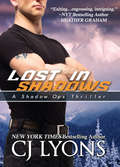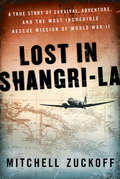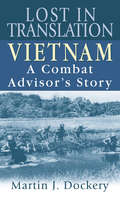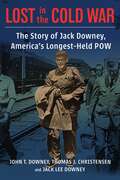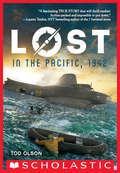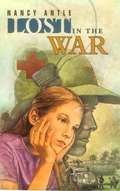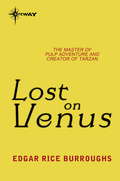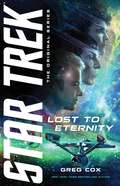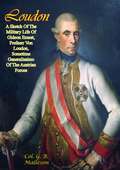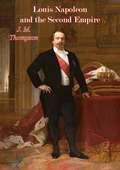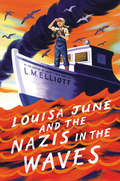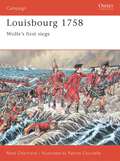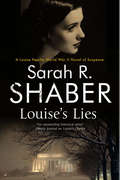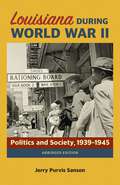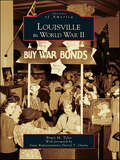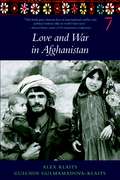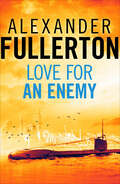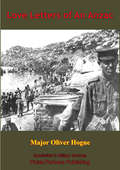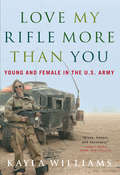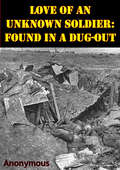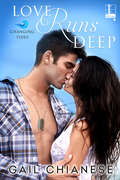- Table View
- List View
Lost in Shadows (Shadow Ops #2)
by CJ LyonsNew York Times–Bestselling Author: An explosives specialist confronts killers—and his own conflicted heart—in the West Virginia wilderness . . . A West Virginia mountain, the middle of a blizzard, killers on his trail . . . no place for a city boy like Lucky Cavanaugh, an ATF explosives specialist. Outmanned, outgunned, and shot, he takes Forest Service Wildlife Biologist Vinnie Ryan hostage until he convinces her that he&’s one of the good guys. Vinnie heals not only his injuries but also his broken heart. But when they uncover a terrorist plot, Lucky is forced to choose between duty and passion, risking the life of the woman he loves in order to save the lives of thousands.Praise for CJ Lyons: &“A perfect blend of romance and suspense. My kind of read.&” —Sandra Brown, #1 New York Times–bestselling author of Thick as Thieves &“Everything a great thriller should be—action packed, authentic, and intense.&” — Lee Child, #1 New York Times–bestselling author of the Jack Reacher novels &“A pulse-pounding adrenaline rush.&” —Lisa Gardner, #1 New York Times–bestselling author of Before She Disappeared
Lost in Shangri-La: A True Story of Survival, Adventure, and the Most Incredible Rescue Mission of World War II (P. S. Series)
by Mitchell ZuckoffOn May 13, 1945, twenty-four American servicemen and WACs boarded a transport plane for a sightseeing trip over "Shangri-La," a beautiful and mysterious valley deep within the jungle-covered mountains of Dutch New Guinea. Unlike the peaceful Tibetan monks of James Hilton's bestselling novel Lost Horizon, this Shangri-La was home to spear-carrying tribesmen, warriors rumored to be cannibals. But the pleasure tour became an unforgettable battle for survival when the plane crashed. Miraculously, three passengers pulled through. Margaret Hastings, barefoot and burned, had no choice but to wear her dead best friend's shoes. John McCollom, grieving the death of his twin brother also aboard the plane, masked his grief with stoicism. Kenneth Decker, too, was severely burned and suffered a gaping head wound. Emotionally devastated, badly injured, and vulnerable to the hidden dangers of the jungle, the trio faced certain death unless they left the crash site. Caught between man-eating headhunters and enemy Japanese, the wounded passengers endured a harrowing hike down the mountainside-a journey into the unknown that would lead them straight into a primitive tribe of superstitious natives who had never before seen a white man-or woman. Drawn from interviews, declassified U.S. Army documents, personal photos and mementos, a survivor's diary, a rescuer's journal, and original film footage, Lost in Shangri-La recounts this incredible true-life adventure for the first time. Mitchell Zuckoff reveals how the determined trio-dehydrated, sick, and in pain-traversed the dense jungle to find help; how a brave band of paratroopers risked their own lives to save the survivors; and how a cowboy colonel attempted a previously untested rescue mission to get them out. By trekking into the New Guinea jungle, visiting remote villages, and rediscovering the crash site, Zuckoff also captures the contemporary natives' remembrances of the long-ago day when strange creatures fell from the sky. A riveting work of narrative nonfiction that vividly brings to life an odyssey at times terrifying, enlightening, and comic, Lost in Shangri-La is a thrill ride from beginning to end.
Lost in Tibet: The Untold Story of Five American Airmen, a Doomed Plane, and the Will to Survive
by Richard Starks Miriam MurcuttCaught in a violent storm and blown far off their intended course, five American airmen--flying the dangerous Himalayan supply route known as "The Hump"--were forced to bail out just seconds before their plane ran out of fuel. To their astonishment, they found they had landed in the heart of Tibet. There they had to confront what, to them, seemed a bizarre--even alien--people. At the same time, they had to extricate themselves from the political turmoil that even then was raging around Tibet's right to be independent from China.Now back in print,Lost in Tibet is an extraordinary story of high adventure that sheds light on the remarkable Tibetan people, just at the moment when they were coming to terms with a hostile outside world.
Lost in Translation: Vietnam A Combat Advisor's Story
by Martin J. DockeryIn September 1962, when Martin Dockery landed in Saigon, he was a young, determined, idealistic U. S. Army first lieutenant convinced of America’s imminent victory in Vietnam. While most of the twelve thousand U. S. military advisors in-country at the time filled support positions in Saigon and other major cities, Dockery was one of a handful of advisors assigned to Army of the Republic of Vietnam (ARVN) combat units. For eight months Dockery lived and fought in the heart of the Mekong Delta with an ARVN infantry battalion on missions and operations that often lasted several days. And for most of that time, whether tramping through the steaming, leech-infested jungle, hiking across canals, or engaging in sudden firefights, Dockery was the only American soldier with the unit. Dockery’s solitary assignment with ARVN during the infancy of U. S. involvement in Southeast Asia afforded him an understanding of Vietnam far more profound than most other Americans. Lost in Translation is his riveting account of the largely overlooked role of American combat advisors in the war. As he vividly evokes the sounds, smells, and vistas of the country and its people, Dockery depicts an army poorly trained, incompetent, and unwilling to fight for a government every bit as corrupt as that of the French colonial empire it replaced. Yet even worse than his daily fare of isolation, frustration, and danger was Dockery’s growing conviction that the advisory program was doomed. Though these dedicated, highly motivated advisors would do their best and persevere under the most trying circumstances, they would not succeed. The author’s eyewitness testimony provides inescapable evidence that as early as 1962 the writing was already on the wall concerning the outcome of the Vietnam War. Although it would take U. S. leaders more than a decade to divine what the young officer learned in a single year, Dockery’s personal and penetrating analysis of the war—which he presented in a lecture at a Special Forces facility in Germany one week after his tour in Vietnam ended—proved chillingly accurate. Those who send soldiers to war should consider the realities and truths within these pages. From the Hardcover edition.
Lost in the Cold War: The Story of Jack Downey, America’s Longest-Held POW (A Nancy Bernkopf Tucker and Warren I. Cohen Book on American–East Asian Relations)
by Thomas Christensen John T. Downey Jack DowneyIn 1952, John T. “Jack” Downey, a twenty-three-year-old CIA officer from Connecticut, was shot down over Manchuria during the Korean War. The pilots died in the crash, but Downey and his partner Richard “Dick” Fecteau were captured by the Chinese. For the next twenty years, they were harshly interrogated, put through show trials, held in solitary confinement, placed in reeducation camps, and toured around China as political pawns. Other prisoners of war came and went, but Downey and Fecteau’s release hinged on the United States acknowledging their status as CIA assets. Not until Nixon’s visit to China did Sino-American relations thaw enough to secure Fecteau’s release in 1971 and Downey’s in 1973.Lost in the Cold War is the never-before-told story of Downey’s decades as a prisoner of war and the efforts to bring him home. Downey’s lively and gripping memoir—written in secret late in life—interweaves horrors and deprivation with humor and the absurdities of captivity. He recounts his prison experiences: fearful interrogations, pantomime communications with his guards, a 3,000-page overstuffed confession designed to confuse his captors, and posing for “show” photographs for propaganda purposes. Through the eyes of his captors and during his tours around China, Downey watched the Great Leap Forward, the Cultural Revolution, and the drastic transformations of the Mao era. In interspersed chapters, Thomas J. Christensen, an expert on Sino-American relations, explores the international politics of the Cold War and tells the story of how Downey and Fecteau’s families, the CIA, the U.S. State Department, and successive presidential administrations worked to secure their release.
Lost in the Pacific, 1942: Not a Drop to Drink (Lost #1)
by Tod OlsonLOST IN THE PACIFIC is the first book in a new narrative nonfiction series that tells the true story of a band of World War II soldiers who became stranded at sea and had to fight for survival.World War II, October 21, 1942. A B-17 bomber drones high over the Pacific Ocean, sending a desperate SOS into the air. The crew is carrying America's greatest living war hero on a secret mission deep into the battle zone. But the plane is lost, burning through its final gallons of fuel.At 1:30 p.m., there is only one choice left: an emergency landing at sea. If the crew survives the impact, they will be left stranded without food or water hundreds of miles from civilization. Eight men. Three inflatable rafts. Sixty-eight million square miles of ocean. What will it take to make it back alive?
Lost in the War
by Nancy AntleTwelve-year-old Lisa Grey struggles to cope with a mother whose traumatic experiences as a nurse in Vietnam during the war are still haunting her.
Lost in the Wilds
by Edward Sylvester EllisIn "Lost in the Wilds," Edward Sylvester Ellis weaves a gripping tale of adventure, survival, and self-discovery in the unforgiving wilderness. Set against the backdrop of the untamed American frontier, this timeless novel captures the essence of human resilience and the relentless spirit of exploration.The story follows young protagonists who find themselves stranded in the wild after a series of unforeseen events. Facing the daunting challenges of nature, they must rely on their wits, courage, and the invaluable lessons of their upbringing to navigate the perilous terrain. As they encounter wild animals, treacherous landscapes, and unpredictable weather, their journey becomes a profound test of endurance and ingenuity.Ellis's masterful storytelling brings the wilderness to life with vivid descriptions and a deep appreciation for the natural world. His characters are richly drawn, each grappling with their fears and doubts while discovering hidden strengths and forging unbreakable bonds. The narrative deftly balances thrilling action with moments of introspection, allowing readers to connect with the characters on a deeply emotional level."Lost in the Wilds" is more than just an adventure story; it is a celebration of the human spirit's capacity to overcome adversity. Through the trials and triumphs of his characters, Ellis explores themes of friendship, perseverance, and the transformative power of nature. His keen observations and heartfelt prose resonate with readers of all ages, making this book a cherished classic in the genre of wilderness adventure.As the young adventurers navigate their way back to safety, they learn invaluable life lessons that shape their character and worldview. Ellis's narrative serves as a poignant reminder of the importance of resilience, resourcefulness, and the enduring human connection to the natural world.Whether you are an avid outdoors enthusiast or simply a lover of captivating storytelling, "Lost in the Wilds" offers a compelling and inspirational read. Edward Sylvester Ellis's timeless tale of survival and discovery continues to enchant and inspire readers, reaffirming the boundless potential of the human spirit.
Lost on Venus: Venus Book 2
by Edgar Rice BurroughsIn the Room of the Seven Doors, Carson Napier faced the choice of his life. Six doors led to terrible deaths - the seventh was the door of life. But for him, this door too would lead only to the new dangers of a planet whose beasts were more frightful than those of his native Earth.But Carson sought the rescue of the planet's fairest princess, and even though he stepped from one danger to meet another, he was determined to make good an Earthman's pledge.
Lost to Eternity (Star Trek: The Original Series)
by Greg CoxA thrilling new Star Trek &“movie era&” novel from New York Times bestselling author Greg Cox!Three Eras. Three Mysteries. One Ancient Enemy? 2024: Almost forty years ago, marine biologist Gillian Taylor stormed away from her dream job at Sausalito&’s Cetacean Institute—and was never seen or heard from again. Now a new true crime podcast has reopened that cold case, but investigator Melinda Silver has no idea that her search for the truth about Gillian&’s disappearance will ultimately stretch across time and space—and attract the attention of a ruthless obsessive with his own secret agenda. 2268: The U.S.S. Enterprise&’s five-year mission is interrupted when Captain James T. Kirk and his crew set out to recover an abducted Federation scientist whose classified secrets are being sought by the Klingons as well. The trail leads to a barbaric world off limits to both Starfleet and the Klingon Empire—and an ageless mastermind on a quest for eternity. 2292: The Osori, an ancient alien species, has finally agreed to establish relations with its much younger neighbors: the Federation, the Klingons, and the Romulans. A joint mission involving ships from all three powers, including the Enterprise-A, turns explosive when one of the Osori envoys is apparently killed. Each side blames the others, but the truth lies buried deep, nearly three hundred years in the past… TM & © 2023 CBS Studios Inc. Star Trek and related marks and logos are trademarks of CBS Studios Inc. All Rights Reserved.
Loudon: Sometime Generalissimo Of The Austrian Forces
by Col. G. B. MallesonFew Generals left such a shining legacy of military genius and glory than Frederick the Great and his Prussian army, however, this reputation was hard fought and grimly won against the forces of Austria. The leading Austrian general, who frustrated many of Frederick's designs, was General Frieherr von Loudon, a soldier through and through. In this detailed biography, noted military author Colonel Malleson traces Loudon's rise from obscurity to the forefront of the Austrian military effort of the Seven Years War. One of the few generals to have bested the Prussians; he won brilliant victories at Hochkirch, Kunersdorf, Landshut, Glatz and Schweidnitz. Frederick himself when talking over the events of the war, then a thing of the past, with his generals, he exclaimed: "We all of us made mistakes, except my brother Henry and Loudon."
Louis Napoleon and the Second Empire
by J. M. ThompsonAn excellent one volume portrait of Napoleon III and the short-lived second French Empire which was brought to ruins by the 1870 Franco-Prussian war.“ONCE again J. M. Thompson has given us a colorful, arresting, and interpretative account of a period of French history—this time of the Second Empire. In this instance, as in previous works, the author makes the biography of a man (Louis Napoleon) the vehicle for a history of a period, thereby infusing the warmth of a very human personality throughout the history of a complex and fateful era. Thus we follow the life of a man who followed his star of fate from youthful refugee to insurrectionist, prisoner, president, emperor, economic reformer, arbiter of a continent, prisoner-of-war, and, alas, to refugee again until death.Nothing of the romance, the contrasts, the shaded significances is lost by the author's telling. Those who have read his French Revolution and Napoleon Bonaparte cannot fail to discern and appreciate the same trenchant pen and deft brush which restore life and odor to a much-told tale of the past. While Mr. Thompson does not attempt to conceal the faults and mistakes of the man, in the main he joins with some current revisionists in understanding (not justifying) the "crime of December 2nd" and crediting Napoleon Ili with constructive policies at home and abroad and exonerating him of the major responsibility for the outbreak of the war of 1870. The author rightly blames Bismarck and French public opinion of all classes for pushing Louis Napoleon into the war (p. 272) rather than just a small war party and the empress.”-Lynn M. Case
Louisa June and the Nazis in the Waves
by L. M. ElliottIn this moving and timeless story, award-winning author L. M. Elliott captures life on the U.S. homefront during World War II, weaving a rich portrait of a family reeling from loss and the chilling yet hopeful voyage of fighting for what matters, perfect for fans of The War That Saved My Life. Days after Japan’s attack on Pearl Harbor in 1941, Hitler declared war on the U.S., unleashing U-boat submarines to attack American ships. Suddenly, the waves outside Louisa June’s farm aren’t for eel-fishing or marveling at wild swans or learning to skull her family’s boat—they’re dangerous, swarming with hidden enemies.Her oldest brothers’ ships risk coming face-to-face with U-boats. Her sister leaves home to weld Liberty Boat hulls. And then her daddy, a tugboat captain, and her dearest brother, Butler, are caught in the crossfire. Her mama has always swum in a sea of melancholy, but now she really needs Louisa June to find moments of beauty or inspiration to buoy her. Like sunshine-yellow daffodils, good books, or news accounts of daring rescues of torpedoed passengers.Determined to help her Mama and aching to combat Nazis herself, Louisa June turns to her quirky friend Emmett and the indomitable Cousin Belle, who has her own war stories—and a herd of cats—to share. In the end, after a perilous sail, Louisa June learns the greatest lifeline is love.
Louisbourg 1758
by Rene Chartrand Patrice CourcelleOsprey's study of James Wolfe's siege of Louisbourg during the French and Indian War (1754-1763). Louisbourg represented a major threat to Anglo-American plans to invade Canada. Bypassing it would leave an immensely powerful enemy base astride the Anglo-American lines of communication - Louisbourg had to be taken. Faced with strong beach defences and rough weather, it took six days to land the troops, and it was only due to a stroke of daring on the part of a young brigadier named James Wolfe, who managed to turn the French beach position, that this was achieved. The story is largely based on firsthand accounts from the journals of several participants, including French Governor Drucour's, whose excellent account has never been published.
Louise's Lies: A 1940s Spy Thriller Set In Wartime Washington D. C. (The Louise Pearlie World War II Novels of Suspense #6)
by Sarah R. Shaber&“Shaber&’s winning sixth WWII mystery is her best yet&”—from the award-winning author of Louise&’s Chance and Louise&’s Crossing (Publishers Weekly, starred review). When a body is discovered in a Washington bar, government girl Louise Pearlie is forced into a role of lies and deception. On a bitterly cold night in December 1943, Louise Pearlie and her friend Joe Prager are enjoying a quiet drink in the Baron Steuben Inn when a bloodstained body is discovered behind the bar. Although the victim had been a regular customer, no one seems to know anything about him. When it turns out there is a link to Louise&’s top-secret work at the OSS, she is ordered to find out as much as possible about the murder while keeping the connection secret from those involved, including the investigating police detective. Although Louise has been trained to keep secrets, the constant deception is taking its toll—especially when she discovers that she&’s not the only customer at the Steuben that night with something to hide. Will Louise&’s silence result in an innocent man being arrested for murder? &“[Louise&’s] sixth adventure is a worthy addition to the franchise.&”—Kirkus Reviews &“Shaber does a fine job portraying the plight of alien residents in wartime Washington, besides conveying the hectic atmosphere of a city whose resources are stretched to the limit by an influx of new workers.&”—Publishers Weekly (starred review)
Louisiana during World War II: Politics and Society, 1939–1945
by Jerry Purvis SansonWhile the impact of World War II on America and other countries has been exhaustively chronicled, few historians have investigated the experiences of individual states during the tumultuous war years. In his study of Louisiana’s home front from 1939 to 1945, Jerry Purvis Sanson examines changes in politics, education, agriculture, industry, and society that forever altered the Pelican State. The war era was a particularly important time in Louisiana’s colorful political history. The gubernatorial victories of prominent anti–Huey Long candidates Sam Jones in 1940 and Jimmie Davis in 1944 reflected shifting sentiments toward politicians and heralded a changing of the guard in the statehouse. This created a system of active dual-faction politics that continued for the next decade. The war also transformed the state’s economy: agricultural mechanization accelerated to compensate for labor shortages, and industries increased production to meet military demands. Louisiana’s educational system modified its curriculum in response to the war, providing technical training and sponsoring scrap-metal collections and war-stamp sales drives. Sanson explores the war’s effect on the everyday lives of Louisianians, showing how their actions at home provided them with a sense of personal participation in the titanic effort against the Axis powers. He also points out that, while many found their lives limited by war, two groups—African Americans and women— experienced increased opportunities as they moved from low-paying jobs to more lucrative positions vacated by white males who had departed for the service. Now condensed for easy and efficient access, Sanson’s historical account provides a wide-ranging yet intimate look at how the war was brought home to the people of the Bayou State.
Louisville in World War II (Images of America)
by Bruce M. TylerWith the bombing of Pearl Harbor in December 1941, Louisville mobilized to fight Nazi Germany and Imperial Japan. Citizens of all races and economic classes united in the effort, both abroad and at home. Louisville�s many industries banded together as well: the Mengel Company made wood products used in the war, and its staff burned a Nazi flag in an employee-held rally; Reynolds Aluminum Company manufactured arms and other war materials; Liberty National Bank sold war bonds at special windows; and the Louisville Ford Motor Company made at least 93,389 military jeeps out of the roughly 500,000 employed in the war. Perhaps Louisville�s most significant war contribution, though, was the use of Bowman Field as a United States Army Air Corps Detachment Squadron. The pilots trained there were vital to the war effort.
Love & War in Afghanistan
by Alex Klaits Gulchin Gulmamadova-KlaitsLove and War in Afghanistan presents true stories of fourteen ordinary men and women living in Northern Afghanistan. In a quarter-century of uninterrupted war, the people of Afghanistan have endured foreign invasions, ethnic strife, a fundamentalist Islamic totalitarian regime, and the unending crossfire of rival warlord factions. The country remains an object of fascination for journalists, academics, and filmmakers from around the world. In the midst of it all it is a startlingly powerful experience to discover, here, the voices of the Afghan people themselves. Young lovers who elope against the wishes of their kin; a mullah whose wit is his only defense against his armed captors; a defector from the Soviet army; a woman who is forced to stand up to gangsters in Tajikistan--their dramatic stories emerge in their own unforgettable words. Whether in the sudden awakening of mercy in a Taliban militiaman, the lingering contempt of a woman for her husband's first wife, the pain and confusion of flight into exile, or the resourcefulness of a child who must provide for an entire family, the real focus of these narratives is the strength of solitary individuals faced daily with their own vulnerability. Men, women, orphans, widows, widowers, Tajiks, Pashtuns, Uzbeks, Turkmens, schoolteachers, mullahs, former Taliban, mujahideen, big brothers, little sisters, captive wives, lovers in flight: Love and War in Afghanistan tells their stories, putting human faces onto a country torn by war.
Love For An Enemy
by Alexander FullertonIn wartime Egypt, can a British submarine commander trust his Italian lover?1941: The teeming city of Alexandria is almost under siege by the Afrika Korps. A vortex of ancient loves and murderous intrigues, Alexandria is the Royal Navy’s major Eastern Mediterranean base. But Italian frogmen and their so-called ‘human torpedoes’ are posing a lethal threat to British warships.Hardly the time or place for a British submarine commander to fall in love, especially as the girl in question is half-Italian, and Alexandria’s large Italian population is only too eager to welcome Rommel and his troops into town. Interspersed with scenes of naval action described in gripping and authentic detail – seen through Italian as much as British eyes – the human drama unfolds, its actors ever aware of the mounting threat of a German breakthrough. A stunning naval thriller sure to enthral readers of Philip McCutchan and Jeff Edwards, Love For An Enemy shows Alexander Fullerton at the peak of his form.Praise for Alexander Fullerton‘The most meticulously researched war novels that I have ever read’ Len Deighton ‘The scene of battle is quite overpowering’ Sunday Times‘His action passages are superb, and he never puts a period foot wrong’ Observer
Love Letters From An Anzac [Illustrated Edition]
by Major Oliver Hogue"Oliver Hogue (1880-1919), journalist and soldier, was born on 29 April 1880 in Sydney ...He enlisted in the Australian Imperial Force in Sep. 1914 as a trooper with the 6th Light Horse Regiment. Commissioned second lieutenant in Nov., he sailed for Egypt with the 2nd L.H. Brigade in the Suevic in Dec..Hogue served on Gallipoli with the Light Horse (dismounted) for five months, then was invalided to England with enteric fever. In May 1915 he was promoted lieutenant and appointed orderly officer to Colonel Ryrie, the brigade commander. As 'Trooper Bluegum' he wrote articles for the Herald subsequently collected in the books Love Letters of an Anzac and Trooper Bluegum at the Dardanelles. Sometimes representing war as almost a sport, he took pride in seeing 'the way our young Australians played the game of war'.Hogue returned from hospital in England to the 6th L.H. in Sinai and fought in the decisive battle of Romani. Transferred to the Imperial Camel Corps on 1 Nov. 1916, he was promoted captain on 3 July 1917. He fought with the Camel Corps at Magdhaba, Rafa, Gaza, Tel el Khuweilfe, Musallabeh, and was with them in the first trans-Jordan raid to Amman. In 1917 Hogue led the 'Pilgrim's Patrol' of fifty Cameliers and two machine-guns into the Sinai desert to Jebel Mousa, to collect Turkish rifles from the thousands of Bedouins in the desert.After the summer of 1918, spent in the Jordan Valley, camels were no longer required. The Cameliers were given horses and swords and converted into cavalry. Hogue, promoted major on 1 July 1918, was now in Brigadier General George Macarthur-Onslow's 5th L.H. Brigade, commanding a squadron of the 14th L.H. Regiment. At the taking of Damascus by the Desert Mounted Corps in Sep. 1918, the 5th Brigade stopped the Turkish Army escaping through the Barada Gorge. As well as the articles sent to Australia, and some in English magazines, Hogue wrote a third book, The Cameliers,..."-Aust. Dict. of Nat. Bio.
Love Like Hate: A Novel
by Linh DinhLinh Dinh is already one of the secret masters of short fiction. Love Like Hate is something like a traditional cross-cultural novel that's been shocked into life by Dinh's uncanny ability to tell us stories we didn't even know we wanted to hear. -- Ed Park, editor of The BelieverIn Love Like Hate, Linh Dinh weaves a dysfunctional family saga that doubles as a portrait of Vietnam in the last half century. Protagonists Kim Lan and Hoang Long marry in Saigon during the Vietnam War, uniting in a setting that allows Dinh's dark, deadpan humor to flourish. Describing his mushrooming cast of characters in unsentimental and sometimes absurd ways, Dinh embraces contradictions with the surreal exuberance of Matthew Sharpe and the stylistic élan of Italo Calvino.
Love My Rifle More Than You: Young and Female in the U.S. Army
by Michael E. Staub Kayla Williams"A woman soldier has to toughen herself up," writes Kayla Williams in this fiercely honest account of what it's like to be part of the female 15 percent of today's Army. "Not just for the enemy, for battle, for death. I mean to toughen herself to spend months awash in a sea of nervy, hyped-up guys " Irreverent, vulnerable, angry, and humane, Williams describes what it's like for a young woman to be surrounded by an ocean of testosterone, respected for her skills and qualifications but treated variously as a soldier, a sister, a mother, a bitch, and a slut. During her five years of service -- including a year of deployment to Iraq during and after the invasionWilliams and her female peers navigate both extreme physical danger and emotional minefields. As a specialist in Military Intelligence, fluent in Arabic language skills, Williams finds herself at the forefront of the troops' interaction with local people. Brave and patriotic, with a strong sense of duty to her country and her fellow soldiers, +
Love My Rifle More than You: Young and Female in the U.S. Army
by Michael E. Staub Kayla Williams"Brave, honest, and necessary."--Nancy Pearl, NPR Seattle Kayla Williams is one of the 15 percent of the U.S. Army that is female, and she is a great storyteller. With a voice that is "funny, frank and full of gritty details" (New York Daily News), she tells of enlisting under Clinton; of learning Arabic; of the sense of duty that fractured her relationships; of being surrounded by bravery and bigotry, sexism and fear; of seeing 9/11 on Al-Jazeera; and of knowing she would be going to war. With a passion that makes her memoir "nearly impossible to put down" (Buffalo News) Williams shares the powerful gamut of her experiences in Iraq, from caring for a wounded civilian to aiming a rifle at a child. Angry at the bureaucracy and the conflicting messages of today's military, Williams offers us "a raw, unadulterated look at war" (San Antonio Express News) and at the U.S. Army. And she gives us a woman's story of empowerment and self-discovery.
Love Of An Unknown Soldier: Found In A Dug-Out [Illustrated Edition]
by AnonymousIncludes the First World War Illustrations Pack - 73 battle plans and diagrams and 198 photos'I think of you, as I shall think of you to the end, if the end comes. I do not want you less. I want you more perhaps, only not so selfishly. I realize that death does not finish all things. Love lives on. There are other worlds--there must be so many other worlds--in which I shall surely meet you if I miss you in this one. That I, so poor and human and puny, should be capable of this largeness of spirit, gives me confidence that God's scheme for us must be greater than we have guessed. He cannot be smaller than the souls He has created. You may not need me in this existence. We may have met too late to be much to each other. But I cannot think love is wasted.'The Love of an Unknown Soldier collects the intimate letters written by an anonymous World War I officer in Paris to his American love. Found by a young British soldier at the end of the war, the documents had been wedged in the wall of an abandoned gun dug-out, secreted away, and never mailed by the original author. There was no indication of the name or unit of the writer, presumed dead, nor did he mention the name of the girl he loved so dearly. Since tracing the letters' owner proved impossible, the young officer sent them to the publisher John Lane in an attempt to bring the letters to the attention of the American woman for whom the letters were written. The lady was never found, however, and the romantic soldier remains a mystery today.First published in 1916, this touching correspondence provides a clear depiction of the emotional realities and devastation of war.'- Print ed.
Love Runs Deep (Changing Tides #1)
by Gail ChianeseActive duty is no time for romance, but when two naval officers find themselves in truly close quarters on the USS California, the temptation to fraternize is hard to resist. Can two ambitious sailors follow orders long enough to see if love is on the horizon when they’re finally above water? Lieutenant Nic Riley is the only girl in a long-time Navy family, and she’s determined to prove she’s just as seaworthy as her brothers. When she aces training for submarine duty, it calls for a celebration—and one incredibly hot guy is happy to party with her all night long. But when Nic boards the sub and finds herself face to face with her hunky fling, the idea of spending six months underwater takes on a whole new meaning . . . Having a girl in every port was Lieutenant Kyle Hutchinson’s style—until the explosive night he spent with Nic. Dating onboard is firmly off limits, but Kyle can’t get her off his mind much less out of his vicinity—until a junior seaman’s devastating stunt puts Nic’s career in danger. Kyle won’t let her take the heat alone, even when it means risking his own reputation, but fighting for a future together will be a whole new battle . . .
